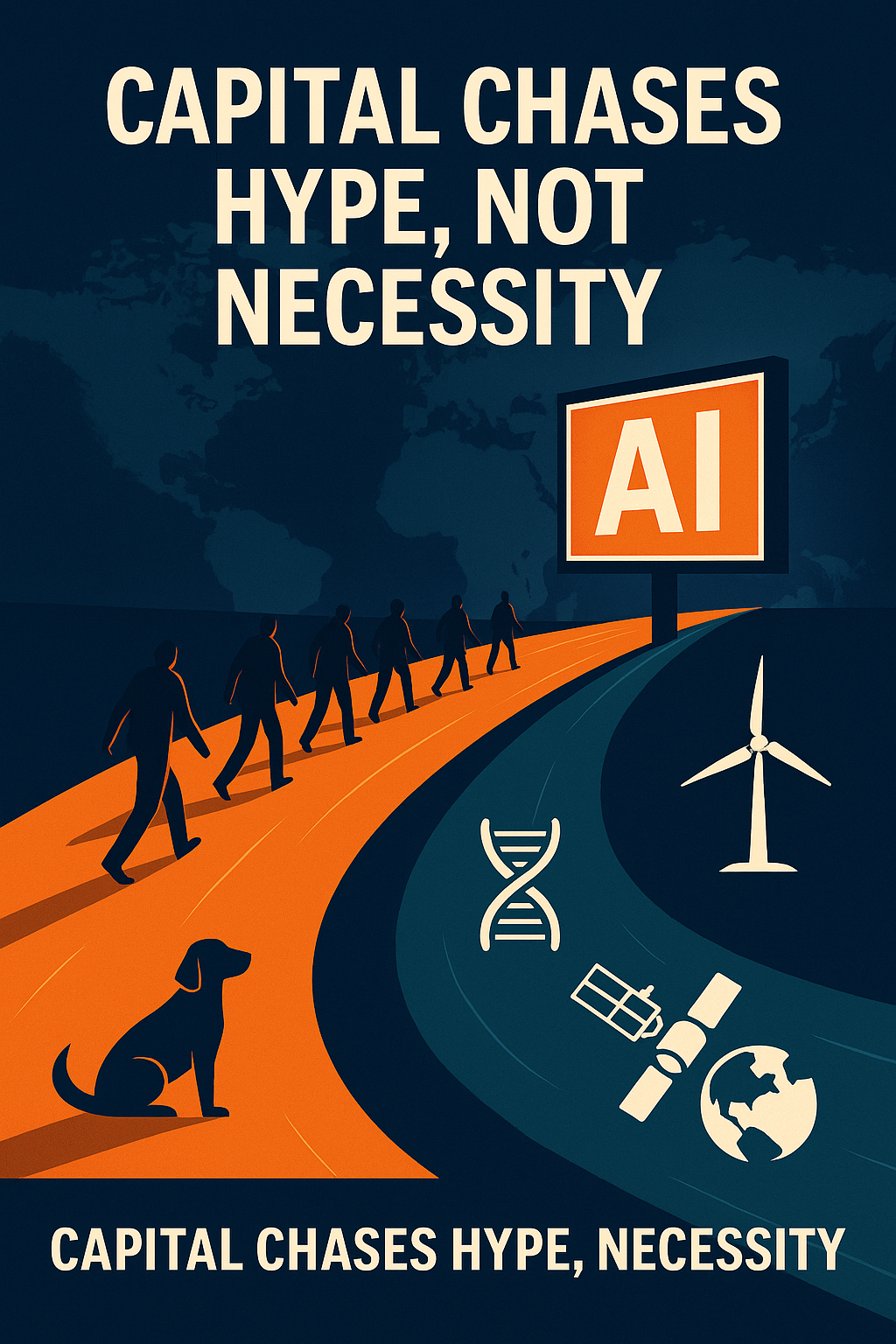Capital Chases Hype, Not Necessity

3 Takeaways
- AI attracts record sums because it is fast, visible, and narratively simple.
- Sectors with long timelines or complex science — animal health, deep tech, climate, infrastructure — fight for attention.
- Mispriced capital slows progress in industries critical to resilience.
Venture capital often markets itself as the engine of disruption. But in practice, it tends to flow toward what’s most visible, fastest to demo, and loudest in narrative. That’s why AI has pulled ahead, while other industries — equally essential, often harder — are left fighting for capital.
As Strategic Advisor to All on Four VC (www.aof.vc), a fund focused on biotech and digital health in animal care, I’ve seen first-hand how these dynamics play out: excellent science and large markets, but slow capital traction compared to “hyped” sectors.
The AI Boom vs. Everyone Else (Backed by Data)
- Corporate and Private AI Investment: In 2024, corporate AI investment reached USD 252.3 billion, with private investment up 44.5% year-over-year. Generative AI startup funding alone hit USD 33.9 billion, up ~18.7% from 2023. (hai.stanford.edu)
- Companion Animal Health Market Growth: The global companion animal health market was about USD 23.08 billion in 2023, projected to reach USD 42.50 billion by 2030 (~9.3% CAGR). (grandviewresearch.com)
- Animal Health R&D in Europe: The European animal medicines industry invests over €600 million per year in R&D. (animalhealtheurope.eu)
The contrast is stark: AI commands torrents of capital, while vital but quieter markets like animal health continue to build slowly.
Shared Traits of Underfunded Sectors
- Scientific or Regulatory Complexity
Requires domain knowledge (biology, regulation, physics). Deters generalist LPs. - Extended Time to Revenue / Exit
Years of trials or engineering before revenue; AI can ship in weeks. - High Capex or Upfront Capital
Labs, satellites, or infrastructure need heavy initial spend. - Low Visibility or Narrative Appeal
Vaccines for livestock don’t make headlines. AI demos do. - First-Time Fund / Specialist Disadvantage
LPs recycle capital into incumbents, leaving domain-specific emerging managers structurally excluded.
The Consequences
- Pet Health Gap: Chronic animal conditions underfunded despite rising demand.
- Food Security Risk: Underinvestment in livestock health leaves zoonotic vulnerabilities.
- Climate Drag: Critical energy and infrastructure tech moves too slowly for climate targets.
- Deep Tech Drift: Quantum and advanced materials risk grant-dependence.
- Systemic Distortion: Progress is skewed toward hype, not resilience.
The Market Consequences of Mispriced Attention
When sectors like animal health, climate tech, and deep science are underfunded, the damage extends beyond innovation into capital markets themselves:
- Concentration Risk: Too much money crowds into AI and a handful of funds, inflating valuations and leaving portfolios overexposed.
- Lower Diversification: Pension funds and sovereigns mirror each other — overweight AI, underweight resilience — reducing systemic stability.
- Delayed Value Creation: Capital markets rely on a pipeline of IPOs. Underfunded sectors mean thinner pipelines.
- Mispriced Risk: By ignoring complex, slower domains, investors undervalue the industries most critical to productivity.
- Policy Spillovers: Governments step in with subsidies or industrial policy, distorting free capital allocation further.
A Challenge to LPs
For Limited Partners, the choice is not just about where the next unicorn comes from. It’s about portfolio resilience.
- Concentration in hype creates fragility. Overweight AI, underweight real-world sectors, and portfolio correlation spikes.
- Diversification is alpha. Animal health, deep tech, and climate infrastructure are multi-billion markets growing steadily — but underrepresented in VC allocations.
- Timing is leverage. The best returns in these sectors accrue to those who enter early, before attention re-prices them.
LPs often say they want differentiated managers and strategies. Here is the test: will you fund the hard, overlooked domains that shape real economies — or chase the theme already priced in?
The invitation is clear: re-balance your portfolio. Fund the sectors that matter, not just the ones that trend.
Why It Matters
AI deserves its boom. But we cannot allow visibility and narrative to dictate which industries move forward. The overlooked sectors — from animal health to deep tech to climate infrastructure — underpin resilience and global stability.
Capital allocation today is not neutral. It decides which futures accelerate, and which stall.
This isn’t about which idea is hottest. It’s about which sectors we allow to fall behind.
Verified Sources
- Stanford HAI, AI Index Report 2025 — corporate/private AI investment. (hai.stanford.edu)
- Grand View Research, Companion Animal Health Market — size and forecast. (grandviewresearch.com)
- AnimalHealthEurope, Investment in R&D — European animal medicines industry R&D spend. (animalhealtheurope.eu)





